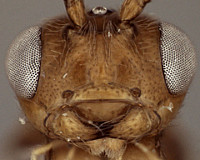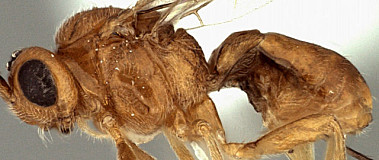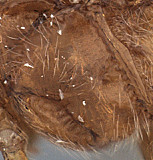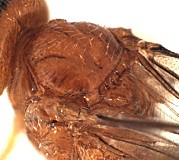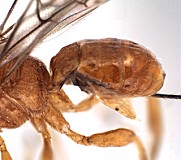Diachasma alloeum (Muesebeck, 1956)
Remarks
Although currently placed in the genus Diachasma because of the shortened clypeus, Diachasma alloeum and two closely related species, Diachasma ferrugineum (Gahan) and Diachasma muliebre (Muesebeck), share many morphological and biological similarities with the New World species of the genus Diachasmimorpha (Wharton 1997), and in particular Diachasmimorpha mellea, which also attacks apple maggot as well as several of the walnut husk flies.
Additional comments, can be found under the Diachasma page.
Taxonomic History / Nomenclature
Much of the biological information on this species is published under the name Opius alloeus.
Diagnosis and Relationships
A key for distinguishing the three North American species of Diachasma that have been reared from Tephritidae is provided by Wharton and Marsh (1978).
The ovipositor is distinctly longer than the body in Diachasma alloeum, and about equal in length to the body in the other two species of Diachasma. However, this character needs to be more critically examined because of potential allometry problems associated with hosts (and resulting parasitoids) that vary considerably in size.
This species superficially resembles Diachasmimorpha mellea, but the two can be readily distinguished by differences in the clypeus, which is short (broadly exposing the labrum) in D. alloeum.
Distribution
Diachasma alloeum was for many years known only from eastern North America (Ontario to New Brunswick in Canada and Maine, Connecticut, New York, Pennsylvania and Florida), where it attacks Rhagoletis pomonella (Walsh) (Wharton and Marsh 1978). It has more recently been recorded from the state of Washington, and I have also seen material from Michigan. See comments under the hosts section.
Distribution
Native
New Brunswick (Marsh, P. M. 1979.)
Ontario (Monteith, L. G. 1977.; Marsh, P. M. 1979.)
Minnesota (Fischer, M. 1970.; Marsh, P. M. 1979.)
Pennsylvania (Muesebeck, C. F. W. 1967.; Marsh, P. M. 1979.)
Identification of Species and Subspecies
Recently published evidence suggests that D. alloeum has formed new incipient species as a result of diversifying on different fly hosts in the tephritid genus Rhagoletis (Forbes et al. (2009)).
Biology / Hosts
Rhagoletis pomonella (Walsh) is the primary host. Also reared from the blueberry maggot, Rhagoletis mendax at Michigan State University, based on material sent to Texas A&M for identification (Stelinski et al. 2004, Stelinski and Liburd 2005, Stelinski et al. 2006). See Forbes et al. (2009) for a discussion of host use patterns associated with sequential sympatric speciation.
Biology and Behavior
Biological Control
Parasitism levels were hypothesized to be too low to be of use in controlling populations of R. pomonella in Quebec based on detailed life history tables for this pest (Cameron and Morrison 1977).

